flat tire TOYOTA C-HR 2020 Warranties & Maintenance Guides (in English)
[x] Cancel search | Manufacturer: TOYOTA, Model Year: 2020, Model line: C-HR, Model: TOYOTA C-HR 2020Pages: 260, PDF Size: 8.54 MB
Page 11 of 260
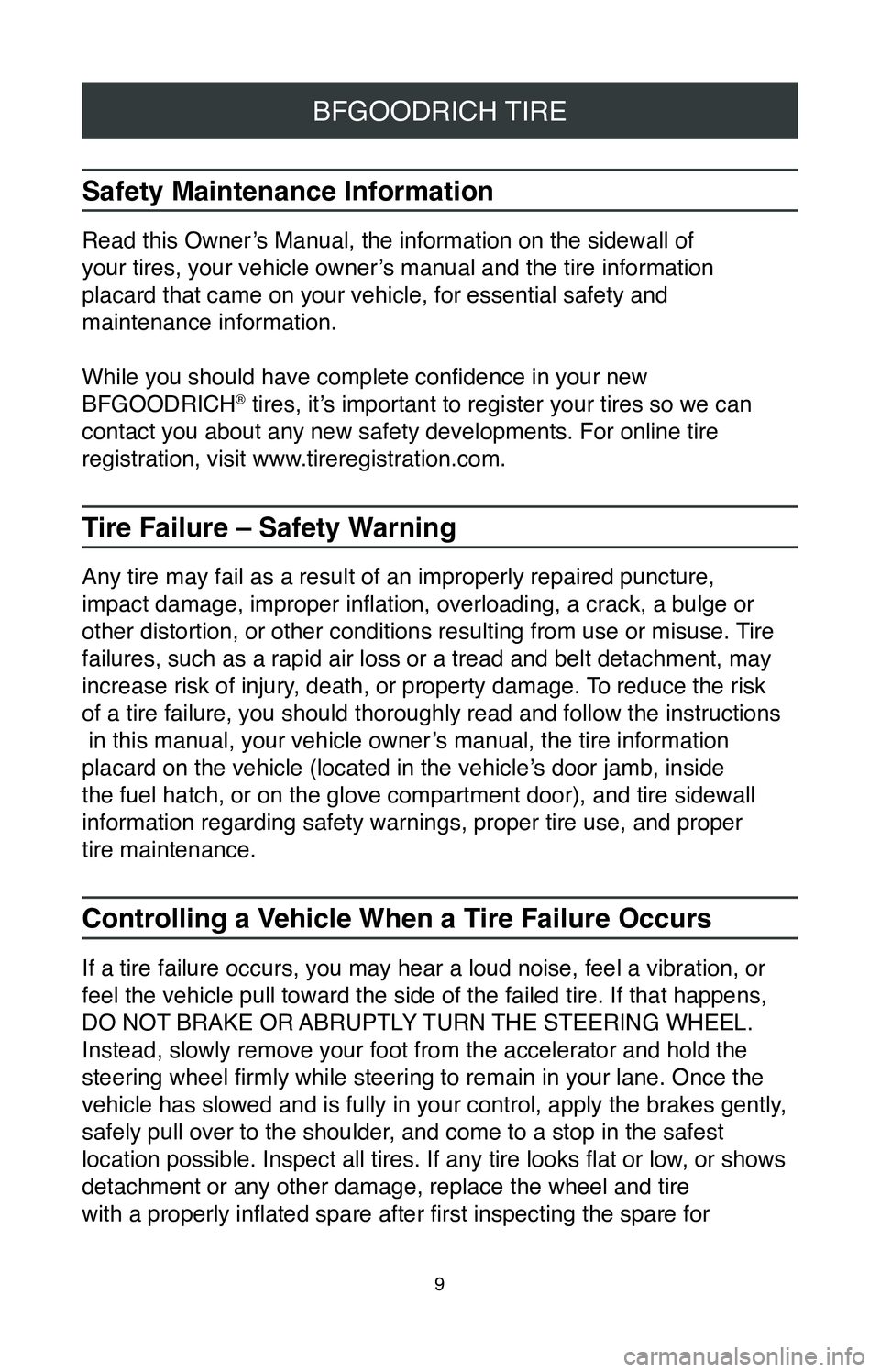
9
BFGOODRICH TIRE
Safety Maintenance Information
Read this Owner’s Manual, the information on the sidewall of
your tires, your vehicle owner’s manual and the tire information
placard that came on your vehicle, for essential safety and
maintenance information.
While you should have complete confidence in your new
BFGOODRICH
® tires, it’s important to register your tires so we can
contact you about any new safety developments. For online tire
registration, visit www.tireregistration.com.
Tire Failure – Safety Warning
Any tire may fail as a result of an improperly repaired puncture,
impact damage, improper inflation, overloading, a crack, a bulge or
other distortion, or other conditions resulting from use or misuse. Tire
failures, such as a rapid air loss or a tread and belt detachment, may
increase risk of injury, death, or property damage. To reduce the risk
of a tire failure, you should thoroughly read and follow the instruction\
s
in this manual, your vehicle owner’s manual, the tire information
placard on the vehicle (located in the vehicle’s door jamb, inside
the fuel hatch, or on the glove compartment door), and tire sidewall
information regarding safety warnings, proper tire use, and proper
tire maintenance.
Controlling a Vehicle When a Tire Failure Occurs
If a tire failure occurs, you may hear a loud noise, feel a vibration, o\
r
feel the vehicle pull toward the side of the failed tire. If that happen\
s,
DO NOT BRAKE OR ABRUPTLY TURN THE STEERING WHEEL.
Instead, slowly remove your foot from the accelerator and hold the
steering wheel firmly while steering to remain in your lane. Once the
vehicle has slowed and is fully in your control, apply the brakes gently\
,
safely pull over to the shoulder, and come to a stop in the safest
location possible. Inspect all tires. If any tire looks flat or low , or shows
detachment or any other damage, replace the wheel and tire
with a properly inflated spare after first inspecting the spare for
Page 12 of 260
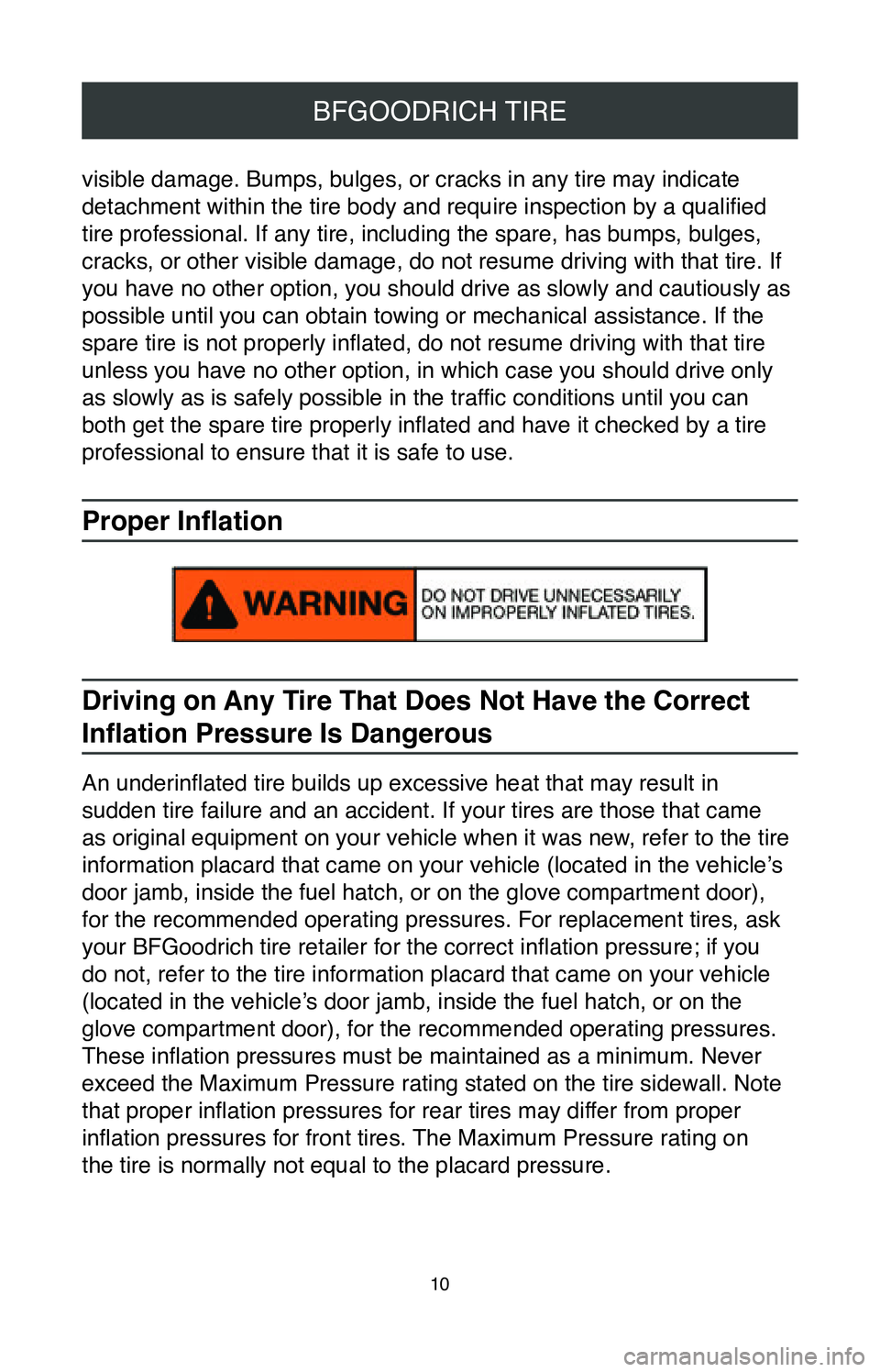
10
BFGOODRICH TIRE
visible damage. Bumps, bulges, or cracks in any tire may indicate
detachment within the tire body and require inspection by a qualified
tire professional. If any tire, including the spare, has bumps, bulges, \
cracks, or other visible damage, do not resume driving with that tire. I\
f
you have no other option, you should drive as slowly and cautiously as
possible until you can obtain towing or mechanical assistance. If the
spare tire is not properly inflated, do not resume driving with that tire
unless you have no other option, in which case you should drive only
as slowly as is safely possible in the traffic conditions until you can
both get the spare tire properly inflated and have it checked by a tire
professional to ensure that it is safe to use.
Proper Inflation
Driving on Any Tire That Does Not Have the Correct
Inflation Pressure Is Dangerous
An underinflated tire builds up excessive heat that may result in
sudden tire failure and an accident. If your tires are those that came
as original equipment on your vehicle when it was new, refer to the tire
information placard that came on your vehicle (located in the vehicle’s
door jamb, inside the fuel hatch, or on the glove compartment door),
for the recommended operating pressures. For replacement tires, ask
your BFGoodrich tire retailer for the correct inflation pressure; if you
do not, refer to the tire information placard that came on your vehicle \
(located in the vehicle’s door jamb, inside the fuel hatch, or on the
glove compartment door), for the recommended operating pressures.
These inflation pressures must be maintained as a minimum. Never
exceed the Maximum Pressure rating stated on the tire sidewall. Note
that proper inflation pressures for rear tires may differ from proper
inflation pressures for front tires. The Maximum Pressure rating on
the tire is normally not equal to the placard pressure.
Page 13 of 260
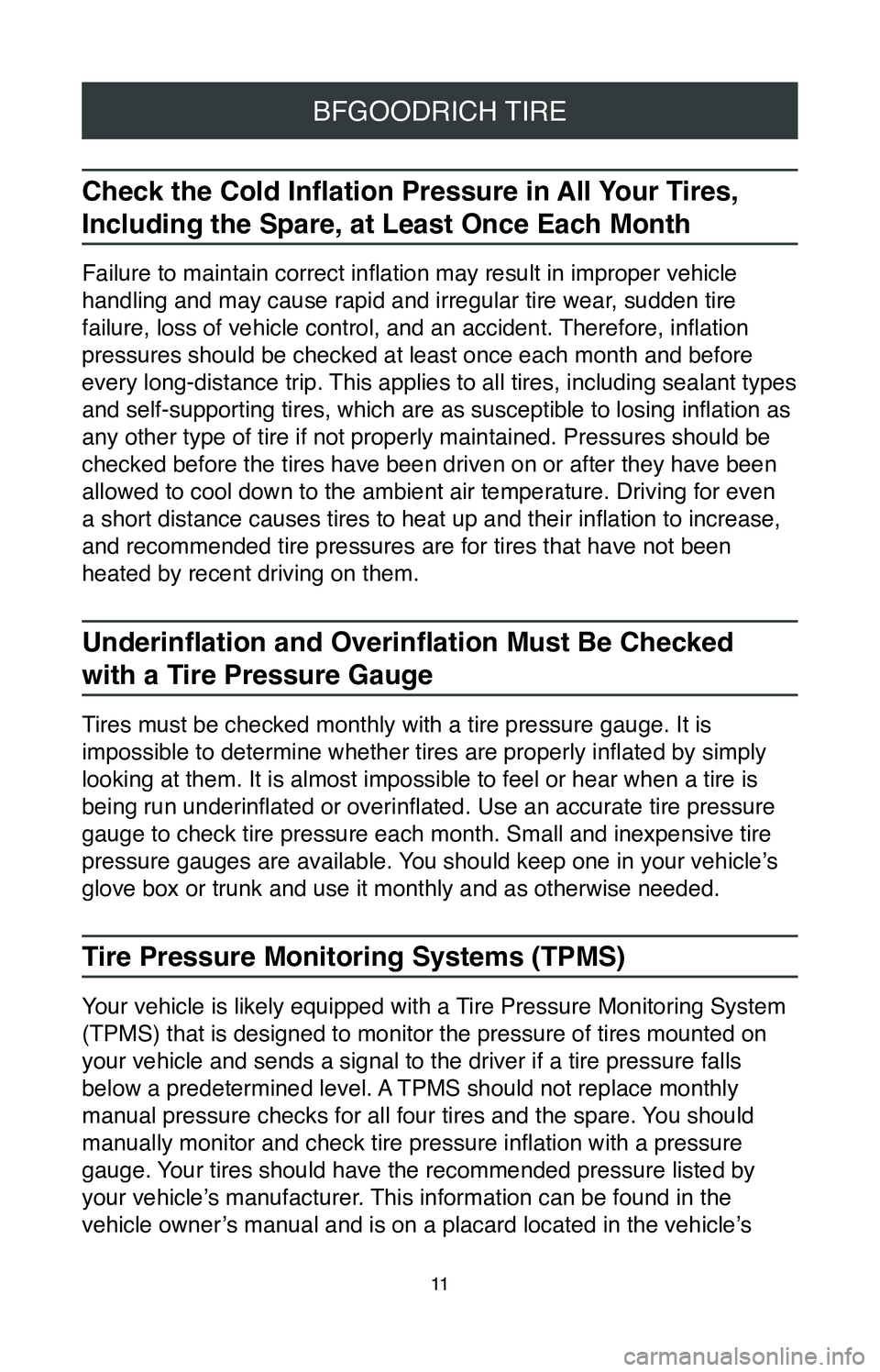
11
BFGOODRICH TIRE
Check the Cold Inflation Pressure in All Your Tires,
Including the Spare, at Least Once Each Month
Failure to maintain correct inflation may result in improper vehicle
handling and may cause rapid and irregular tire wear, sudden tire
failure, loss of vehicle control, and an accident. Therefore, inflation
pressures should be checked at least once each month and before
every long-distance trip. This applies to all tires, including sealant types
and self-supporting tires, which are as susceptible to losing inflation as
any other type of tire if not properly maintained. Pressures should be
checked before the tires have been driven on or after they have been
allowed to cool down to the ambient air temperature. Driving for even
a short distance causes tires to heat up and their inflation to increase,
and recommended tire pressures are for tires that have not been
heated by recent driving on them.
Underinflation and Overinflation Must Be Checked
with a Tire Pressure Gauge
Tires must be checked monthly with a tire pressure gauge. It is
impossible to determine whether tires are properly inflated by simply
looking at them. It is almost impossible to feel or hear when a tire is \
being run underinflated or overinflated. Use an accurate tire pressure
gauge to check tire pressure each month. Small and inexpensive tire
pressure gauges are available. You should keep one in your vehicle’s
glove box or trunk and use it monthly and as otherwise needed.
Tire Pressure Monitoring Systems (TPMS)
Your vehicle is likely equipped with a Tire Pressure Monitoring System
(TPMS) that is designed to monitor the pressure of tires mounted on
your vehicle and sends a signal to the driver if a tire pressure falls
below a predetermined level. A TPMS should not replace monthly
manual pressure checks for all four tires and the spare. You should
manually monitor and check tire pressure inflation with a pressure
gauge. Your tires should have the recommended pressure listed by
your vehicle’s manufacturer. This information can be found in the
vehicle owner’s manual and is on a placard located in the vehicle’s
Page 14 of 260
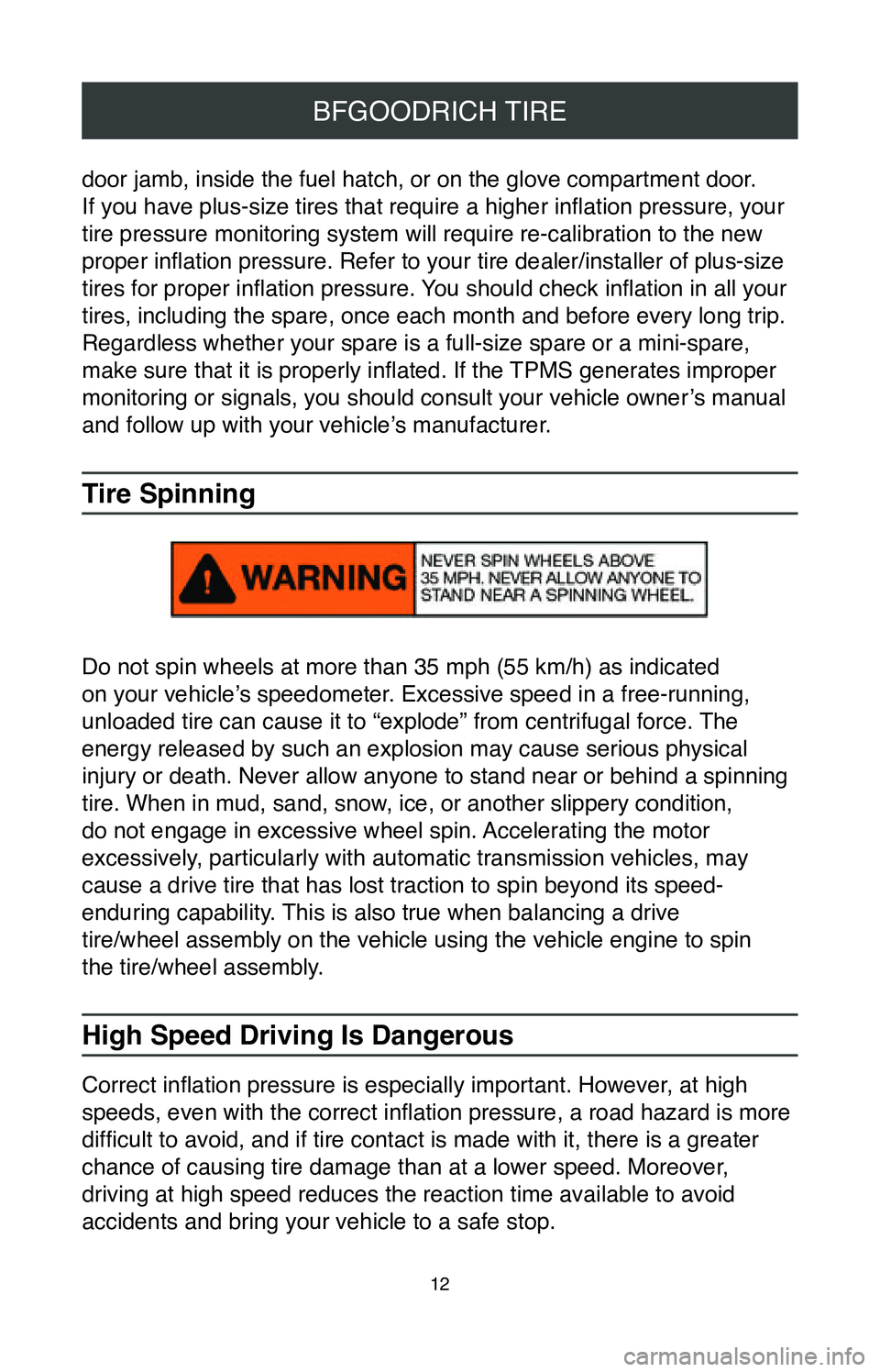
12
BFGOODRICH TIRE
door jamb, inside the fuel hatch, or on the glove compartment door.
If you have plus-size tires that require a higher inflation pressure, your
tire pressure monitoring system will require re-calibration to the new
proper inflation pressure. Refer to your tire dealer/installer of plus-size
tires for proper inflation pressure. You should check inflation in all your
tires, including the spare, once each month and before every long trip. \
Regardless whether your spare is a full-size spare or a mini-spare,
make sure that it is properly inflated. If the TPMS generates improper
monitoring or signals, you should consult your vehicle owner’s manual
and follow up with your vehicle’s manufacturer.
Tire Spinning
Do not spin wheels at more than 35 mph (55 km/h) as indicated
on your vehicle’s speedometer. Excessive speed in a free-running,
unloaded tire can cause it to “explode” from centrifugal force. The
energy released by such an explosion may cause serious physical
injury or death. Never allow anyone to stand near or behind a spinning
tire. When in mud, sand, snow, ice, or another slippery condition,
do not engage in excessive wheel spin. Accelerating the motor
excessively, particularly with automatic transmission vehicles, may
cause a drive tire that has lost traction to spin beyond its speed-
enduring capability. This is also true when balancing a drive
tire/wheel assembly on the vehicle using the vehicle engine to spin
the tire/wheel assembly.
High Speed Driving Is Dangerous
Correct inflation pressure is especially important. However, at high
speeds, even with the correct inflation pressure, a road hazard is more
difficult to avoid, and if tire contact is made with it, there is a greater
chance of causing tire damage than at a lower speed. Moreover,
driving at high speed reduces the reaction time available to avoid
accidents and bring your vehicle to a safe stop.
Page 17 of 260
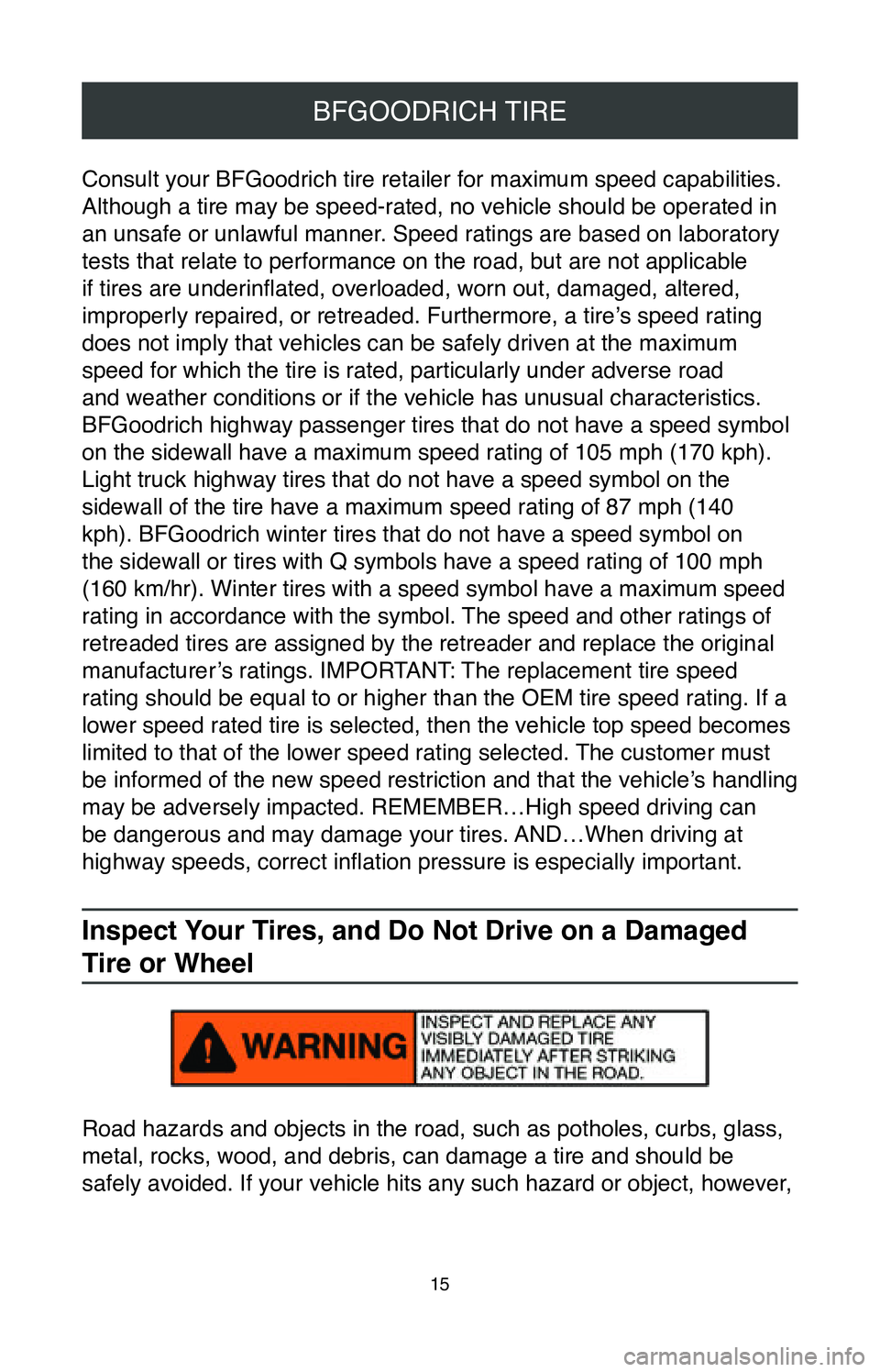
15
BFGOODRICH TIRE
Consult your BFGoodrich tire retailer for maximum speed capabilities.
Although a tire may be speed-rated, no vehicle should be operated in
an unsafe or unlawful manner. Speed ratings are based on laboratory
tests that relate to performance on the road, but are not applicable
if tires are underinflated, overloaded, worn out, damaged, altered,
improperly repaired, or retreaded. Furthermore, a tire’s speed rating
does not imply that vehicles can be safely driven at the maximum
speed for which the tire is rated, particularly under adverse road
and weather conditions or if the vehicle has unusual characteristics.
BFGoodrich highway passenger tires that do not have a speed symbol
on the sidewall have a maximum speed rating of 105 mph (170 kph).
Light truck highway tires that do not have a speed symbol on the
sidewall of the tire have a maximum speed rating of 87 mph (140
kph). BFGoodrich winter tires that do not have a speed symbol on
the sidewall or tires with Q symbols have a speed rating of 100 mph
(160 km/hr). Winter tires with a speed symbol have a maximum speed
rating in accordance with the symbol. The speed and other ratings of
retreaded tires are assigned by the retreader and replace the original
manufacturer’s ratings. IMPORTANT: The replacement tire speed
rating should be equal to or higher than the OEM tire speed rating. If a\
lower speed rated tire is selected, then the vehicle top speed becomes
limited to that of the lower speed rating selected. The customer must
be informed of the new speed restriction and that the vehicle’s handling
may be adversely impacted. REMEMBER…High speed driving can
be dangerous and may damage your tires. AND…When driving at
highway speeds, correct inflation pressure is especially important.
Inspect Your Tires, and Do Not Drive on a Damaged
Tire or Wheel
Road hazards and objects in the road, such as potholes, curbs, glass,
metal, rocks, wood, and debris, can damage a tire and should be
safely avoided. If your vehicle hits any such hazard or object, however,
Page 18 of 260
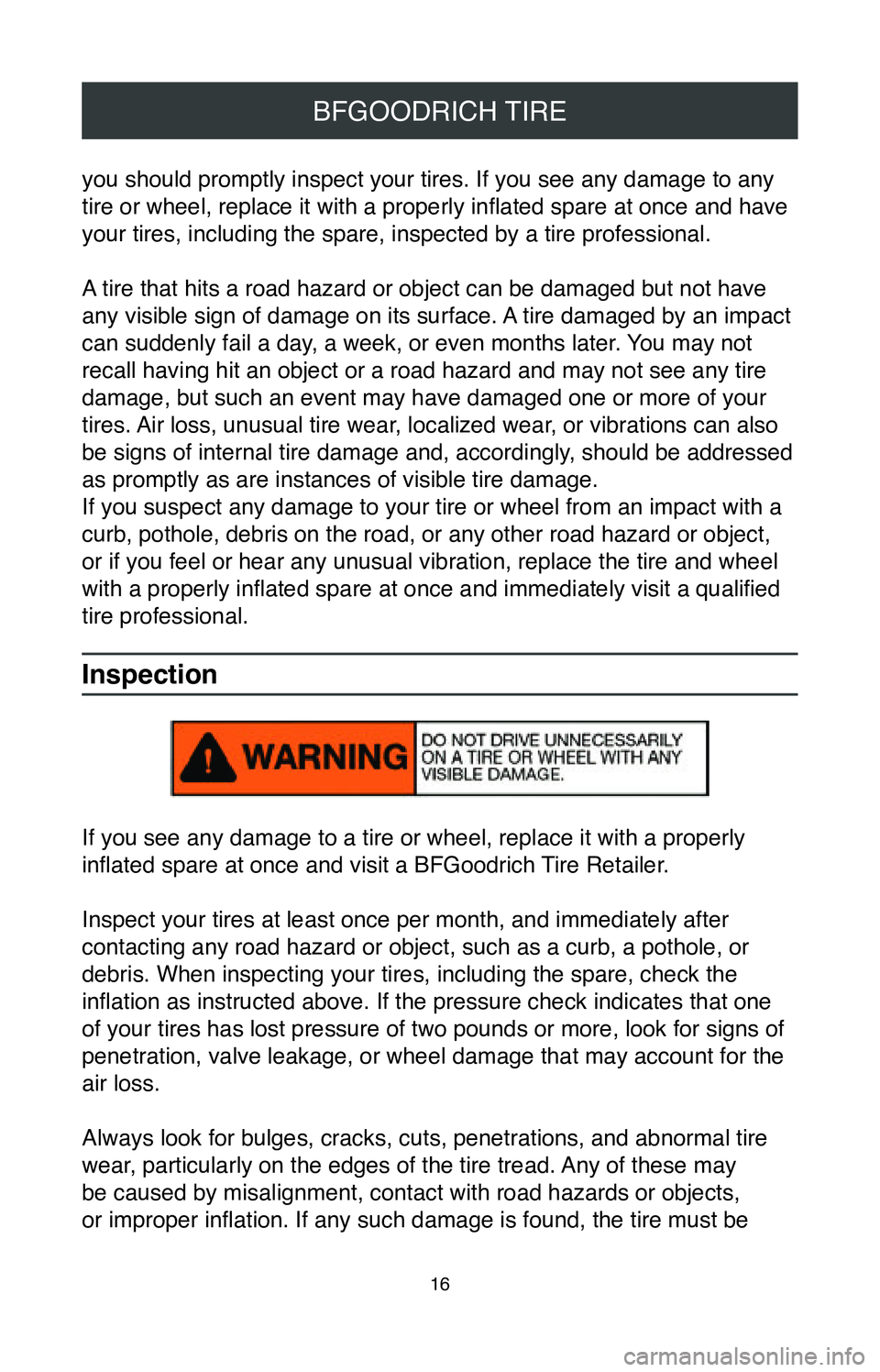
16
BFGOODRICH TIRE
you should promptly inspect your tires. If you see any damage to any
tire or wheel, replace it with a properly inflated spare at once and have
your tires, including the spare, inspected by a tire professional.
A tire that hits a road hazard or object can be damaged but not have
any visible sign of damage on its surface. A tire damaged by an impact
can suddenly fail a day, a week, or even months later. You may not
recall having hit an object or a road hazard and may not see any tire
damage, but such an event may have damaged one or more of your
tires. Air loss, unusual tire wear, localized wear, or vibrations can also
be signs of internal tire damage and, accordingly, should be addressed
as promptly as are instances of visible tire damage.
If you suspect any damage to your tire or wheel from an impact with a
curb, pothole, debris on the road, or any other road hazard or object,
or if you feel or hear any unusual vibration, replace the tire and wheel\
with a properly inflated spare at once and immediately visit a qualified
tire professional.
Inspection
If you see any damage to a tire or wheel, replace it with a properly
inflated spare at once and visit a BFGoodrich Tire Retailer.
Inspect your tires at least once per month, and immediately after
contacting any road hazard or object, such as a curb, a pothole, or
debris. When inspecting your tires, including the spare, check the
inflation as instructed above. If the pressure check indicates that one
of your tires has lost pressure of two pounds or more, look for signs of\
penetration, valve leakage, or wheel damage that may account for the
air loss.
Always look for bulges, cracks, cuts, penetrations, and abnormal tire
wear, particularly on the edges of the tire tread. Any of these may
be caused by misalignment, contact with road hazards or objects,
or improper inflation. If any such damage is found, the tire must be
Page 20 of 260
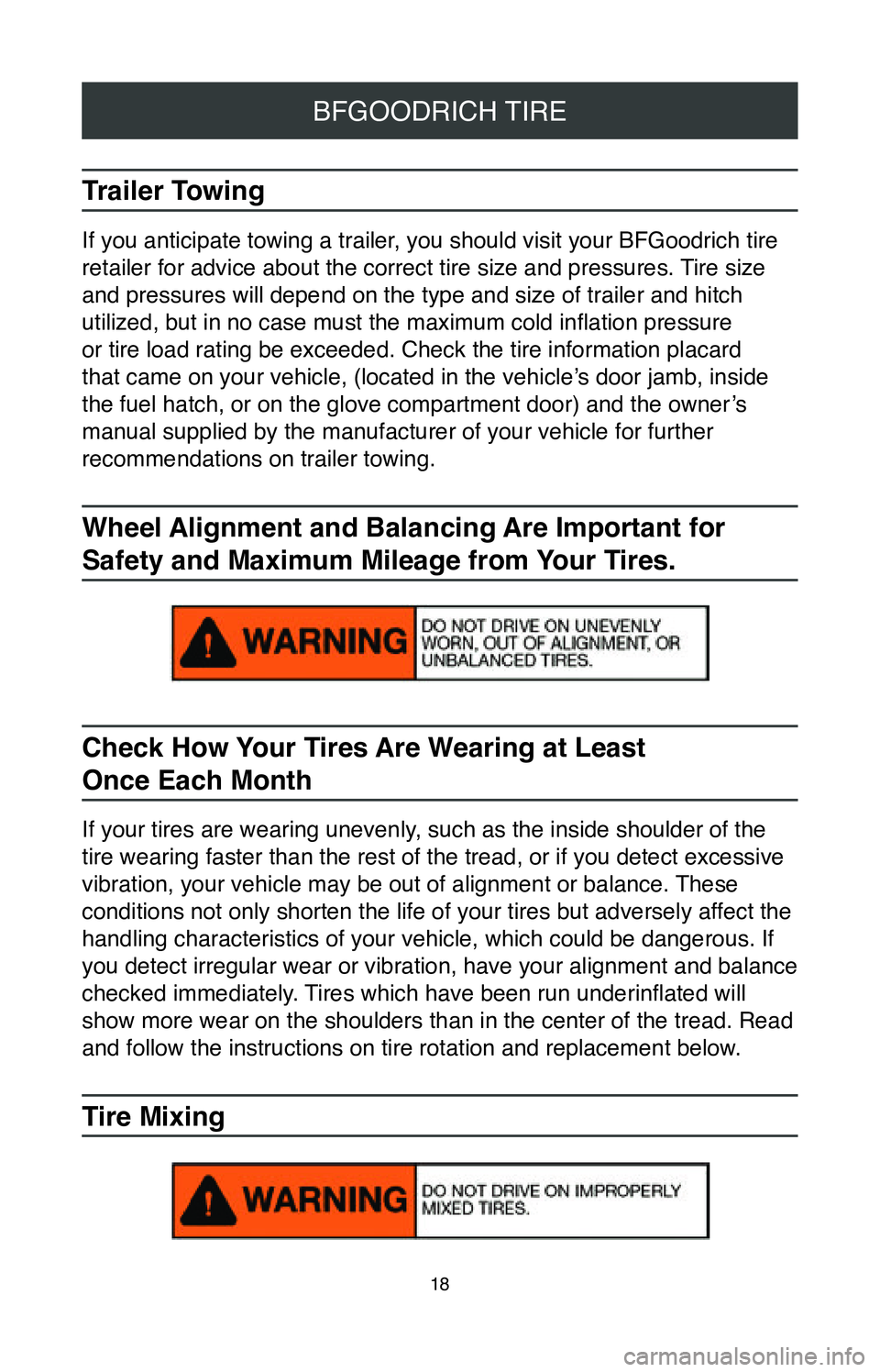
18
BFGOODRICH TIRE
Trailer Towing
If you anticipate towing a trailer, you should visit your BFGoodrich tire
retailer for advice about the correct tire size and pressures. Tire size
and pressures will depend on the type and size of trailer and hitch
utilized, but in no case must the maximum cold inflation pressure
or tire load rating be exceeded. Check the tire information placard
that came on your vehicle, (located in the vehicle’s door jamb, inside
the fuel hatch, or on the glove compartment door) and the owner’s
manual supplied by the manufacturer of your vehicle for further
recommendations on trailer towing.
Wheel Alignment and Balancing Are Important for
Safety and Maximum Mileage from Your Tires.
Check How Your Tires Are Wearing at Least
Once Each Month
If your tires are wearing unevenly, such as the inside shoulder of the
tire wearing faster than the rest of the tread, or if you detect excessi\
ve
vibration, your vehicle may be out of alignment or balance. These
conditions not only shorten the life of your tires but adversely affect the
handling characteristics of your vehicle, which could be dangerous. If
you detect irregular wear or vibration, have your alignment and balance
checked immediately. Tires which have been run underinflated will
show more wear on the shoulders than in the center of the tread. Read
and follow the instructions on tire rotation and replacement below.
Tire Mixing
Page 22 of 260
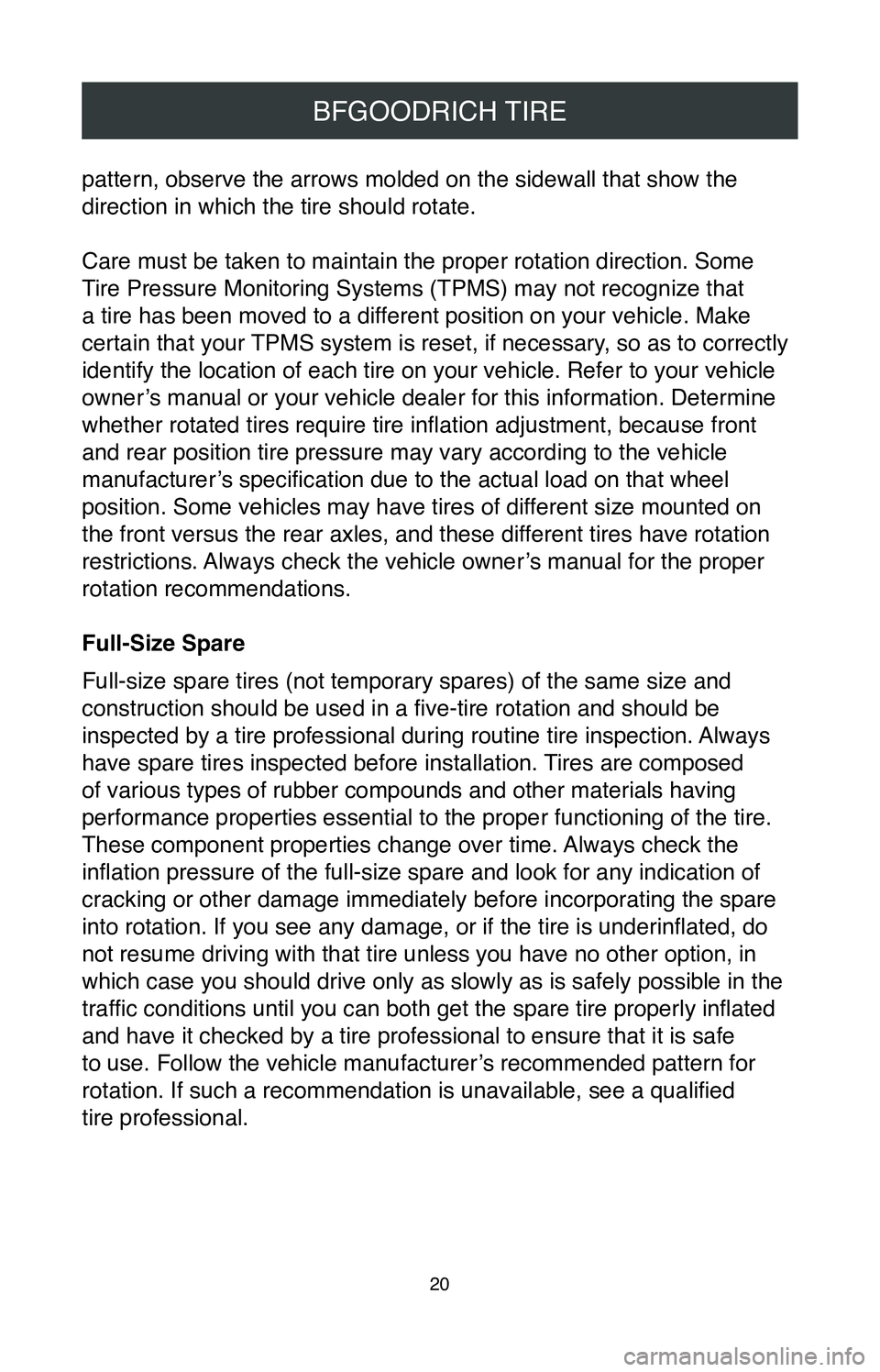
20
BFGOODRICH TIRE
pattern, observe the arrows molded on the sidewall that show the
direction in which the tire should rotate.
Care must be taken to maintain the proper rotation direction. Some
Tire Pressure Monitoring Systems (TPMS) may not recognize that
a tire has been moved to a different position on your vehicle. Make
certain that your TPMS system is reset, if necessary, so as to correctly
identify the location of each tire on your vehicle. Refer to your vehicl\
e
owner’s manual or your vehicle dealer for this information. Determine
whether rotated tires require tire inflation adjustment, because front
and rear position tire pressure may vary according to the vehicle
manufacturer’s specification due to the actual load on that wheel
position. Some vehicles may have tires of different size mounted on
the front versus the rear axles, and these different tires have rotation
restrictions. Always check the vehicle owner’s manual for the proper
rotation recommendations.
Full-Size Spare
Full-size spare tires (not temporary spares) of the same size and
construction should be used in a five-tire rotation and should be
inspected by a tire professional during routine tire inspection. Always
have spare tires inspected before installation. Tires are composed
of various types of rubber compounds and other materials having
performance properties essential to the proper functioning of the tire. \
These component properties change over time. Always check the
inflation pressure of the full-size spare and look for any indication of
cracking or other damage immediately before incorporating the spare
into rotation. If you see any damage, or if the tire is underinflated, do
not resume driving with that tire unless you have no other option, in
which case you should drive only as slowly as is safely possible in the \
traffic conditions until you can both get the spare tire properly inflated
and have it checked by a tire professional to ensure that it is safe
to use. Follow the vehicle manufacturer’s recommended pattern for
rotation. If such a recommendation is unavailable, see a qualified
tire professional.
Page 24 of 260
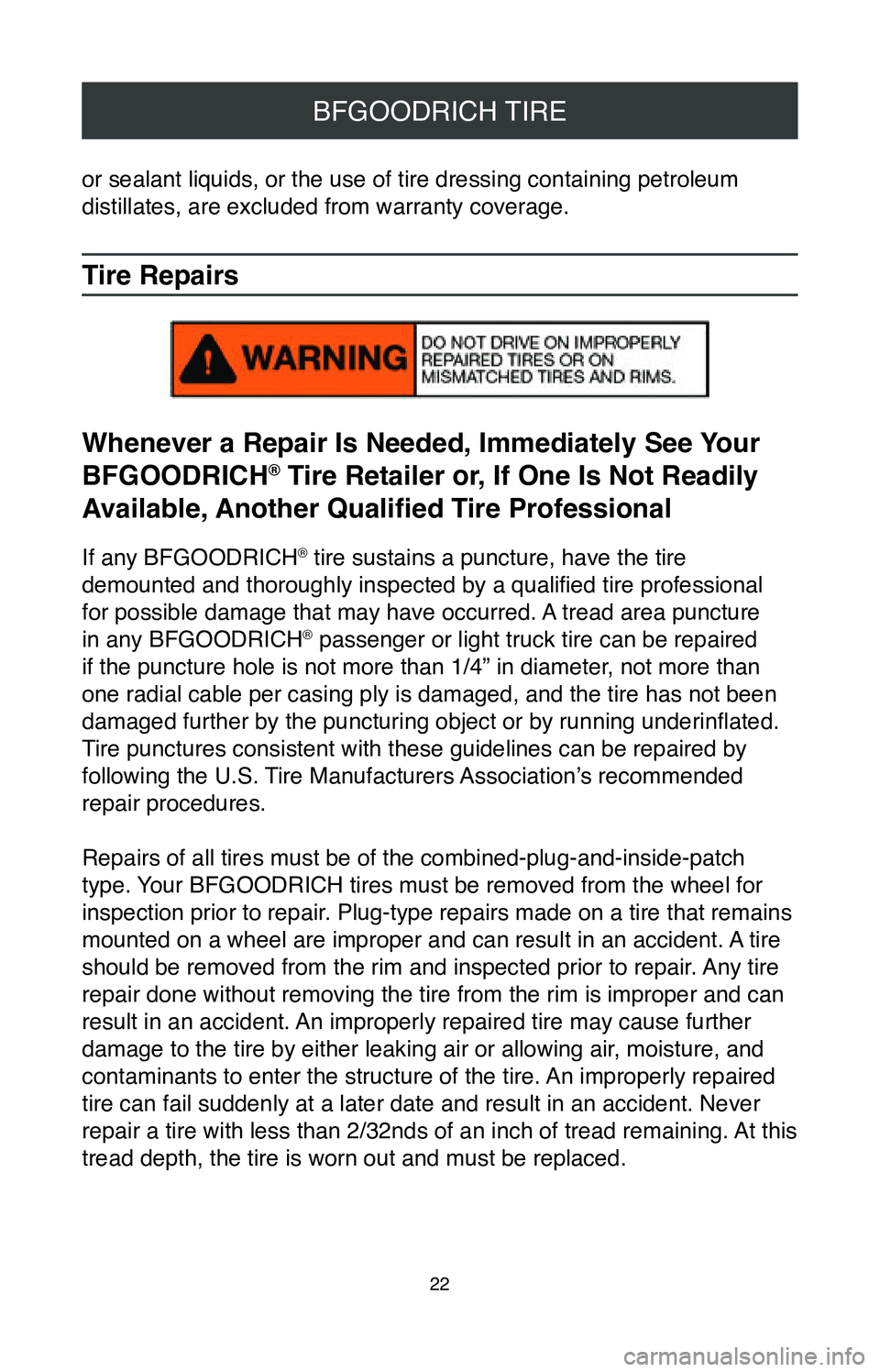
22
BFGOODRICH TIRE
or sealant liquids, or the use of tire dressing containing petroleum
distillates, are excluded from warranty coverage.
Tire Repairs
Whenever a Repair Is Needed, Immediately See Your
BFGOODRICH
® Tire Retailer or, If One Is Not Readily
Available, Another Qualified Tire Professional
If any BFGOODRICH® tire sustains a puncture, have the tire
demounted and thoroughly inspected by a qualified tire professional
for possible damage that may have occurred. A tread area puncture
in any BFGOODRICH
® passenger or light truck tire can be repaired
if the puncture hole is not more than 1/4” in diameter, not more than
one radial cable per casing ply is damaged, and the tire has not been
damaged further by the puncturing object or by running underinflated.
Tire punctures consistent with these guidelines can be repaired by
following the U.S. Tire Manufacturers Association’s recommended
repair procedures.
Repairs of all tires must be of the combined-plug-and-inside-patch
type. Your BFGOODRICH tires must be removed from the wheel for
inspection prior to repair. Plug-type repairs made on a tire that remains
mounted on a wheel are improper and can result in an accident. A tire
should be removed from the rim and inspected prior to repair. Any tire
repair done without removing the tire from the rim is improper and can
result in an accident. An improperly repaired tire may cause further
damage to the tire by either leaking air or allowing air, moisture, and
contaminants to enter the structure of the tire. An improperly repaired
tire can fail suddenly at a later date and result in an accident. Never \
repair a tire with less than 2/32nds of an inch of tread remaining. At this
tread depth, the tire is worn out and must be replaced.
Page 25 of 260
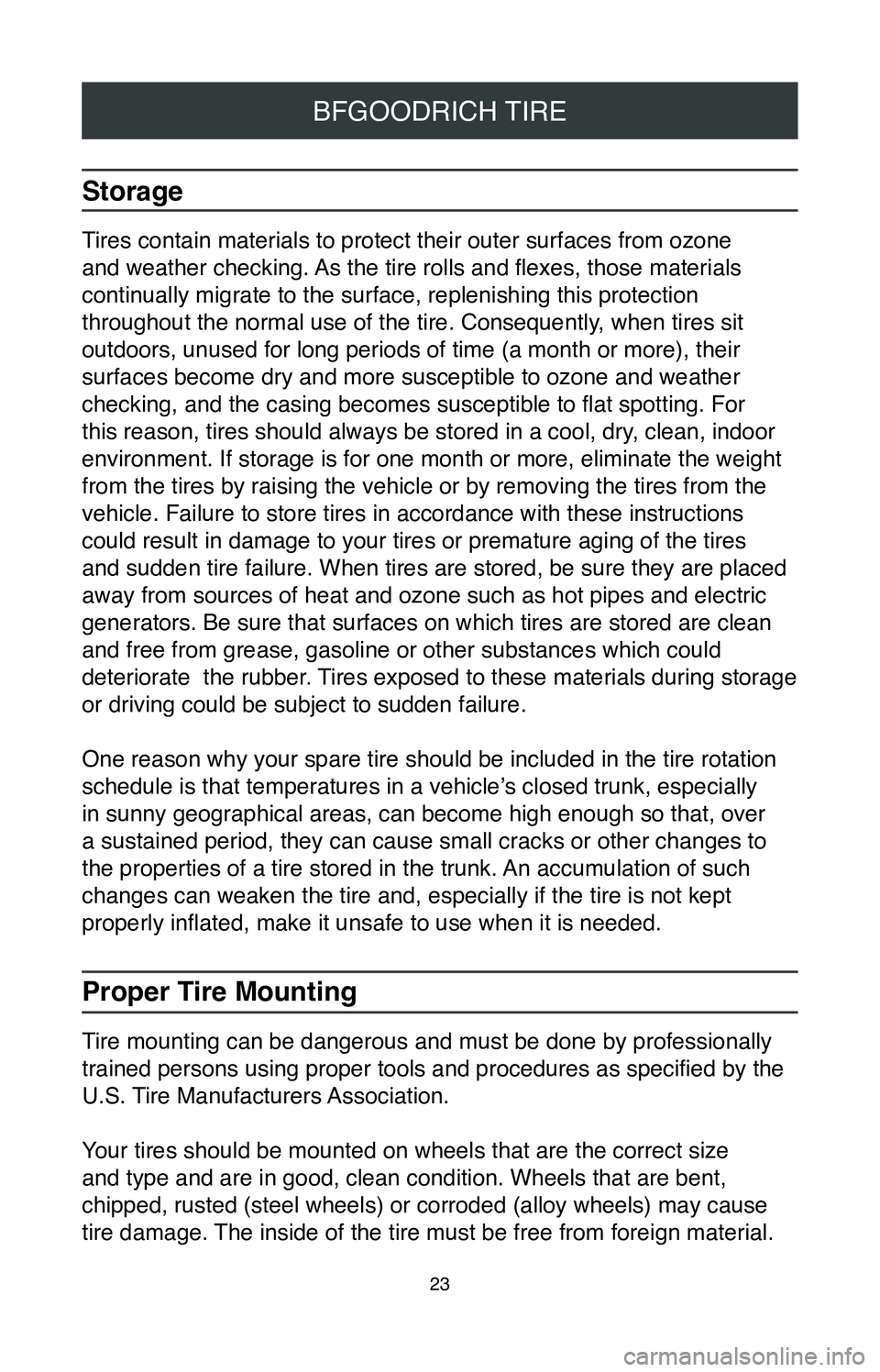
23
BFGOODRICH TIRE
Storage
Tires contain materials to protect their outer surfaces from ozone
and weather checking. As the tire rolls and flexes, those materials
continually migrate to the surface, replenishing this protection
throughout the normal use of the tire. Consequently, when tires sit
outdoors, unused for long periods of time (a month or more), their
surfaces become dry and more susceptible to ozone and weather
checking, and the casing becomes susceptible to flat spotting. For
this reason, tires should always be stored in a cool, dry, clean, indoor
environment. If storage is for one month or more, eliminate the weight
from the tires by raising the vehicle or by removing the tires from the \
vehicle. Failure to store tires in accordance with these instructions
could result in damage to your tires or premature aging of the tires
and sudden tire failure. When tires are stored, be sure they are placed \
away from sources of heat and ozone such as hot pipes and electric
generators. Be sure that surfaces on which tires are stored are clean
and free from grease, gasoline or other substances which could
deteriorate the rubber. Tires exposed to these materials during storage
or driving could be subject to sudden failure.
One reason why your spare tire should be included in the tire rotation
schedule is that temperatures in a vehicle’s closed trunk, especially
in sunny geographical areas, can become high enough so that, over
a sustained period, they can cause small cracks or other changes to
the properties of a tire stored in the trunk. An accumulation of such
changes can weaken the tire and, especially if the tire is not kept
properly inflated, make it unsafe to use when it is needed.
Proper Tire Mounting
Tire mounting can be dangerous and must be done by professionally
trained persons using proper tools and procedures as specified by the
U.S. Tire Manufacturers Association.
Your tires should be mounted on wheels that are the correct size
and type and are in good, clean condition. Wheels that are bent,
chipped, rusted (steel wheels) or corroded (alloy wheels) may cause
tire damage. The inside of the tire must be free from foreign material.